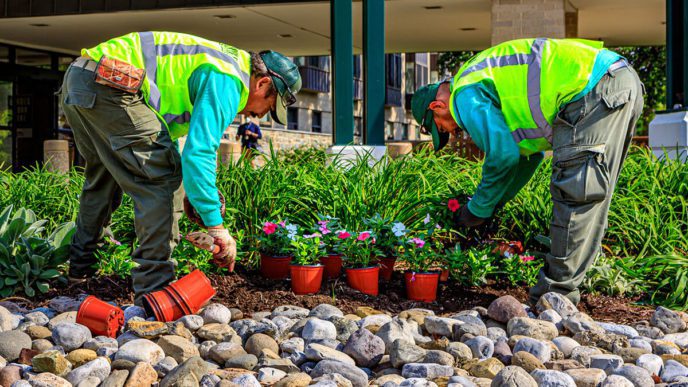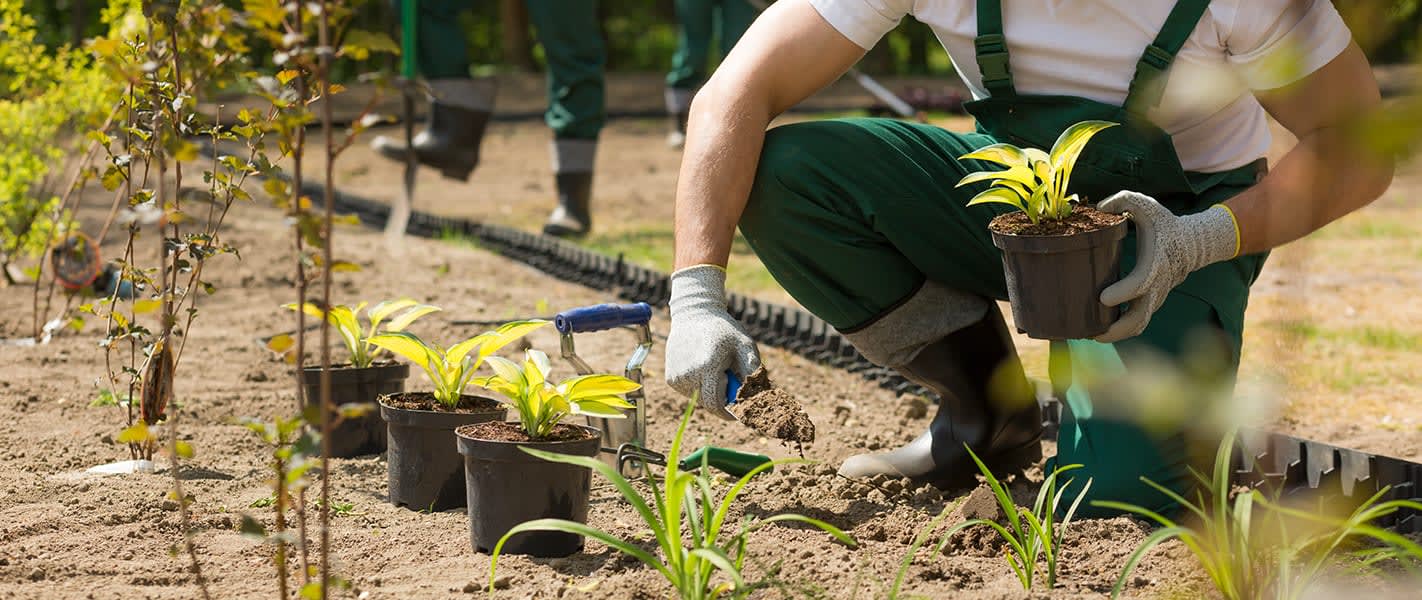Comprehending the Comprehensive Range of Works in Expert Landscaping Services
The extensive extent of expert landscaping services incorporates a range of basic elements - landscaping. It consists of landscape style principles, plant choice, and hardscaping features. Additionally, it addresses watering systems and maintenance strategies. Each aspect plays an essential role in producing useful and visually pleasing outdoor areas. Understanding just how these elements work with each other can disclose much regarding the art and scientific research of landscape design. The trip into this detailed field is simply beginning.
Landscape Layout Concepts
Effective landscape design concepts are vital for producing harmonious outside areas that boost both aesthetic appeal and performance (Learn More). These principles direct the arrangement of components within the landscape, making certain a cohesive visual experience. Trick components consist of equilibrium, which disperses visual weight evenly; proportion, which relates the size of numerous aspects to every various other and the area; and unity, which produces a sense of wholeness through constant motifs and products

Plant Choice and Setup
In the domain of professional landscape design, plant choice and installation play a critical duty in accomplishing a flourishing garden. Highlighting native plant benefits, seasonal considerations, and the details soil and sunshine demands of each types guarantees a lasting and visually pleasing landscape. Careful preparation in these locations not only boosts biodiversity however also promotes long-lasting ecological wellness.
Native Plant Benefits
Why should house owners consider indigenous plants for their landscape design jobs? Indigenous plants provide countless benefits that improve both visual appeals and ecological sustainability. They are well-adapted to regional climates, requiring less water and maintenance compared to non-native varieties. This resilience minimizes the need for chemical plant foods and pesticides, promoting a much healthier ecosystem. In addition, native plants supply environment and food for regional wildlife, consisting of pollinators, which can raise biodiversity in property areas. Their knowledge with neighborhood soil and climate condition likewise brings about far better growth rates and durability. By picking native plants, house owners not only create visually attractive landscapes yet likewise add to ecological conservation, making a favorable effect on their local atmosphere. Indigenous plants stand for a smart choice for landscape design tasks.
Seasonal Plant Considerations
Property owners who have accepted native plants in their landscape design can better boost their outdoor areas by thinking about seasonal plant choices. By incorporating plants that prosper in particular periods, they can develop aesthetically appealing and vibrant landscapes throughout the year. Spring may introduce dynamic flowers like tulips and daffodils, while summer can showcase lavish foliage and vivid perennials. Autumn introduces a scheme of cozy tones with goldenrods and asters, while winter months can be emphasized with evergreens and decorative lawns for structure. Expert landscapers frequently recommend picking plants that not just enhance existing native species yet likewise supply year-round rate of interest and support neighborhood wildlife. This thoughtful approach to seasonal plant option ensures a constantly evolving and lasting garden environment.
Dirt and Sunlight Needs
Successful landscape design hinges on comprehending the specific soil and sunshine requirements of plants. Different varieties prosper under varying problems, needing a mindful evaluation of both elements during the option process. Soil types, such as sandy, clay, or fertile, influence drain, nutrition schedule, and root growth. Furthermore, pH levels can impact plant health, requiring soil screening to ascertain viability. Sunlight demands differ significantly; some plants prosper in complete sunlight, while others choose partial or complete color. A professional landscaping company considers these aspects to guarantee peak growth and visual appeal. By straightening plant options with the setting's specific attributes, landscapes can achieve sustainability, durability, and aesthetic harmony, eventually bring about successful plant facility and lasting maintenance.
Hardscaping Features and Construction

While landscape design commonly stimulates pictures of rich plant and lively blossoms, hardscaping attributes play a vital duty in specifying outside rooms. These components, that include outdoor patios, pathways, keeping walls, and attractive stonework, offer structure and functionality to gardens and backyards. Hardscaping makes use of products such as concrete, timber, stone, and brick, enabling for diverse layouts that complement the natural landscape.
The building and construction of hardscaping attributes needs careful planning and implementation to ensure toughness and aesthetic allure. Specialists assess website problems, drain, and spatial relationships to develop cohesive outdoor settings. Appropriate installation techniques are essential, as they prevent concerns like erosion and moving over time.
Incorporating hardscaping not just enhances the aesthetic passion of a home but additionally helps with exterior tasks, making it a fundamental element of thorough landscape design services. Ultimately, thoughtful hardscaping adds to both the performance and elegance of outdoor areas.
Irrigation Systems and Water Administration
Efficient watering systems and water monitoring are important elements of specialist landscaping, as they ensure that plants obtain the necessary hydration for excellent growth. These systems can differ from simple drip irrigation arrangements to innovative computerized sprinkler systems, developed to fulfill the specific needs of varied landscapes. Correct water monitoring not only enhances water use, minimizing waste, yet additionally enhances plant health and lessens condition risks.
Landscaping experts analyze various elements, consisting of dirt kind, plant varieties, and local climate, to establish customized watering remedies. Additionally, incorporating rainwater harvesting methods can better boost sustainability and performance. Regular upkeep of watering systems is vital to preserve performance and stop leakages, which can bring about water loss and increased costs (Learn More). Ultimately, a properly designed irrigation system plays a pivotal duty in protecting the aesthetic allure of exterior areas while promoting eco-friendly stewardship within expert landscaping techniques
Grass Care and Upkeep Techniques
Yard care and maintenance approaches are essential for achieving a lavish, healthy and balanced yard that boosts the general landscape. These strategies incorporate different techniques aimed at advertising perfect development and aesthetic charm. Regular mowing is necessary, as it encourages thick, also development while stopping weeds from establishing. Furthermore, correct fertilization supplies necessary nutrients, with applications customized to the details turf kind and dirt conditions.
Watering methods should concentrate on deep, seldom irrigation to urge root development, while oygenation boosts dirt structure and advertises vitamins and mineral absorption. Insect and illness monitoring is also important; recognizing concerns early enables effective treatments that decrease damages.
Finally, overseeding can revitalize broken or slim lawns, enhancing density and color. By implementing these targeted lawn care methods, landscape design professionals can guarantee that lawns stay healthy and balanced and vivid throughout the periods, significantly adding to the general elegance of the home
Seasonal Landscape Care and Maintenance
As the periods adjustment, appropriate landscape treatment ends up being crucial for preserving the health and wellness and beauty of outdoor rooms. Each period provides special obstacles and needs. In springtime, landscape specialists focus on trimming, growing, and fertilizing to encourage growth. Summer demands routine watering, weed control, and pest administration to shield newly developed plants.

Throughout the year, seasonal landscape maintenance guarantees that exterior areas remain healthy and visually enticing. Expert services can give tailored upkeep strategies that adapt to the particular requirements of each period, allowing residential or commercial property proprietors to enjoy lively landscapes year-round. In general, seasonal care is a vital aspect of professional landscaping that promotes durability and aesthetic value.

Lasting Landscape Design Practices
An expanding variety of homeowner are accepting sustainable landscaping practices to produce environmentally pleasant outdoor areas. These techniques concentrate on saving resources, enhancing biodiversity, and minimizing environmental impact. Native plants are typically selected for their low tide demands and compatibility with regional environments, minimizing the requirement for chemical fertilizers and chemicals. Rainfall yards and absorptive paving are utilized to handle stormwater drainage, advertising groundwater recharge and reducing erosion.
Additionally, lasting landscape design includes natural horticulture techniques that prioritize soil health and advertise all-natural insect control. Efficient irrigation systems, such as drip irrigation and rain harvesting, aid optimize water use. Furthermore, landscape designers increasingly support for making use of recycled materials, such as redeemed wood and rocks, to lessen waste. By embracing these sustainable practices, home proprietors not just add to eco-friendly conservation but likewise create cosmetically pleasing settings that can thrive with minimal maintenance.
Regularly Asked Concerns
How much time Does a Landscape Design Job Generally Require To Total?
Normally, a landscape design job can take anywhere from a few days to numerous weeks to finish, depending upon the task's style, dimension, and intricacy requirements. Aspects such as weather and resource availability additionally affect timelines.
What Elements Influence the Price of Landscape Design Services?
Different variables influence landscape design service prices, including job dimension, style intricacy, worldly high quality, labor costs, geographical location, and seasonal need. Each aspect adds distinctively to the overall financial demands of a landscape design project.
Are Landscaping Solutions Available Year-Round?
Landscape design services are usually available year-round, although accessibility might vary based upon area, seasonal climate condition, and particular service offerings. Some services could be restricted throughout severe climate or off-peak seasons.
Do Landscaping Firms Deal Warranties on Their Work?
Several landscape design firms do supply service warranties on their job, which can differ in size and coverage. Clients are motivated to ask about specific terms, ensuring they comprehend what is ensured and any conditions that use.
Can I Layout My Landscape Without Professional Aid?
Yes, people can develop their landscapes without professional help. Nonetheless, they might lack competence in plant selection, format, and ecological factors to consider, potentially resulting in less reliable layouts that can call for expensive adjustments later on.
In the domain of specialist landscaping, plant choice and installation play an important role in accomplishing a thriving garden. Home owners who have actually view it now accepted native plants in their landscape design can even more boost their outdoor areas by taking into consideration seasonal plant selections. Effective landscape design hinges on understanding the particular dirt and sunshine needs of plants. Efficient watering systems and water administration are important parts of professional landscape design, as they guarantee that plants receive the necessary hydration for excellent development. Landscaping specialists examine different factors, consisting of soil kind, plant types, and local climate, to create tailored irrigation services.